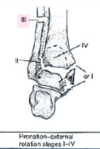9. Trauma Flashcards
What should be done FIRST when assessing a patient with trauma?
Primary survey (ABCDE)
- Airway
- Breathing
- Circulation with hemorrhage control
- Disability – assess neurologic status
- Exposure of patient and environmental control
Secondary survey
- Full history – medical and drug
- Thorough examination
- Evaluate tenderness and stability as well as neurovascular status of each limb
- Is there injury to joint above or below?
- X-rays and/or CT of all suspected fractures
What are the components of a PRIMARY trauma surgery?
(ABCDE)
- Airway
- Breathing
- Circulation with hemorrhage control
- Disability – assess neurologic status
- Exposure of patient and environmental control
What should always be asked with a break in the skin?
Tetanus status
what is a clinical test for a fracture?
point tenderness over fracture site
what are common fracture patterns?
- transverse
- greenstick
- torus
- oblique (spiral)
- comminuted

which fracture pattern is the most stable?
transverse
transverse fracture pattern is the most stable
what is the weakest region of the physis?
zone of cartilage maturation

what is the Vassal principle?
initial fixation of the PRIMARY fracture will assist stabilization of the secondary fracture
name possible complications of fractures
- delayed union
- non-union
- pseudoarthrodesis
- osteoarthritis
- avascular necrosis
what is the timeframe is considered a delayed union?
what about a non-union?
- delayed union: 4-6 months
- non-union: minimum of 9 month old fracture, with at least 3 months of no progress
define: delayed union
- considered a delayed union at 4-6 months
- healing has not advanced at the average rate for the location and type of fracture/osteotomy
treatment: delayed union
can often be healed by strict immobilization alone
define: non-union
- minimum of 9-month-old fracture with no improvement for 3 months
- fracture or osteotomy that does not show improvement during the above timeframe
treatment: non-union
- intervention might include:
- bone stimulator
- operative means
- atrophic nonunions often require a bone graft
define: pseudoarthrosis
- end-stage of a non-union;
- a fibrocartilaginous surface site and a joint space develops that may contain synovial fluid
treatment: pseudoarthrosis
operative intervention is the only reliable method of forming a union involving a pseudoarthrosis
define: malunion
a fracture that heals in an anatomically incorrect position
most common cause:
non-healing for a bone fracture
improper mobilization
name 5 LOCAL factors of
non-healing of bone fractures
- improper immobilization (MC)
- infection
- poor fixation
- distracted fracture
- vascular status
- severity of injury (comminution, local tissue damage)
name 5 GENERAL/SYSTEMIC factors of
non-healing of bone fractures
- smoking
- diabetes
-
endocrinopathies
- thyroid, parathyroid, testosterone deficiency, vit D deficiency
- malnutrition
-
medications
- steroids, chemo, bisphosphonates
- bone quality
who was Lisfranc?
he was a field surgeon in Napoleon’s army
are dorsal or plantar Lisfranc dislocations more common?
DORSAL dislocations are more common
because the plantar ligaments are stronger than dorsal ligaments
what are the Ottowa Ankle Rules?
- A series of ankle X-ray films is required only if there is any pain in the malleolar zone and any of the following findings:
- Bone tenderness at posterior edge or distal 6 cm of lateral malleolus
- Bone tenderness at posterior edge or distal 6 cm of medial malleolus
- Inability to bear weight both immediately and in ED
- A series of foot X-ray films is required only if there is any pain in midfoot zone and any of the following findings:
- Bone tenderness at base of 5th metatarsal
- Bone tenderness at navicular
- Inability to bear weight both immediately and in ED
what is the classification for:
talar dome lesions
Berndt & Hardy


























